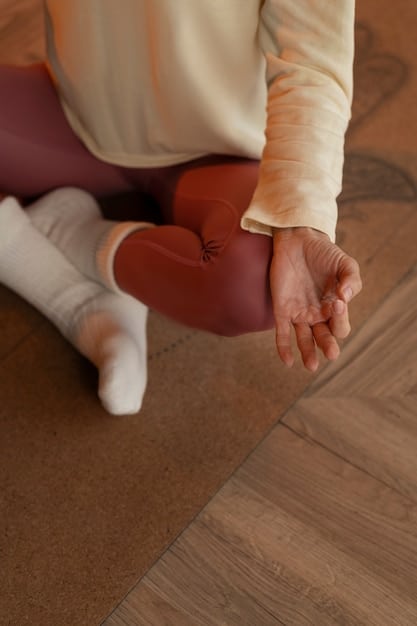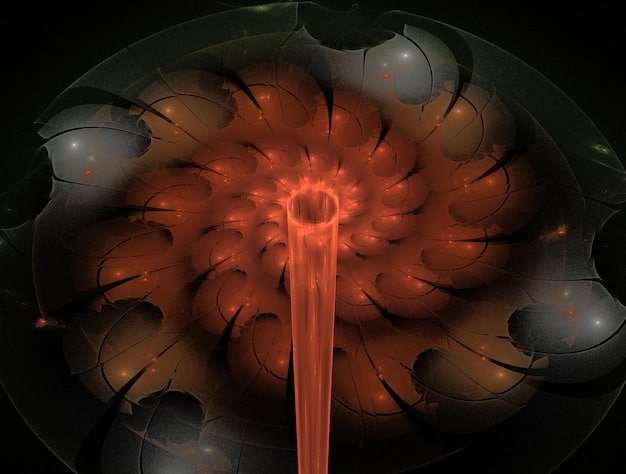Reduce Chronic Pain: Body Scan Meditation Techniques

Body scan meditation techniques offer a potent method to reduce chronic pain by increasing body awareness and promoting relaxation.
Are you seeking effective ways to reduce chronic pain: discover the power of body scan meditation techniques. This practice tunes you into the sensations of your body, fostering relaxation and pain management.
Understanding Chronic Pain and Its Impact
Chronic pain can significantly affect your quality of life. It’s not just a physical sensation; it also impacts your mental and emotional well-being. Understanding this multifaceted aspect is the first step toward finding effective relief.
Chronic pain differs from acute pain in duration and its psychological impacts. Often lasting for more than three months, it can lead to fatigue, sleep disturbances, anxiety, and depression.
The Difference Between Acute and Chronic Pain
Acute pain is a warning signal to the body, indicating injury or illness. Chronic pain, however, persists long after the initial cause has healed.
Psychological Impact of Chronic Pain
Chronic pain can lead to increased stress, anxiety, and even depression. This is often due to the constant discomfort, the limitations it places on daily life, and the uncertainty about the future.
- Chronic pain can significantly impair daily activities, such as work, exercise, and social interactions.
- The constant discomfort of chronic pain can disrupt sleep patterns, leading to fatigue and reduced cognitive function.
- Individuals with chronic pain may experience increased sensitivity to pain due to changes in the central nervous system.
Recognizing the causes, impacts, and mechanisms of chronic pain can help individuals and healthcare professionals to better understand the challenges it presents and to develop more effective treatment strategies.
What is Body Scan Meditation?
Body scan meditation is a mindfulness technique that involves directing your attention to different parts of your body, noticing any sensations without judgment. It is a powerful tool for individuals seeking to reduce chronic pain: discover the power of body scan meditation techniques through increased awareness and relaxation.
This practice encourages a non-reactive observation of physical sensations as they arise and pass away, creating distance between oneself and the intensity of pain.

The Core Principles of Body Scan Meditation
The primary aim is not to change or get rid of any sensations; rather, it focuses on observing them with openness and acceptance.
How Body Scan Differs From Other Meditations
Unlike other meditations that may focus on breath or visualizations, body scan brings the focus directly into the physical body, enabling a deeper connection and understanding of somatic experiences.
- Promotes relaxation by activating the parasympathetic nervous system, helping to decrease stress and tension often associated with chronic pain.
- Improves body awareness, allowing individuals to notice early signs of tension or discomfort that may exacerbate pain.
- Encourages acceptance of present moment experiences, which can reduce the emotional impact of chronic pain and improve coping strategies.
By incorporating body scan meditation into one’s routine, individuals can cultivate a more mindful relationship with their bodies, fostering resilience and enhancing overall well-being.
The Science Behind Body Scan and Pain Reduction
The effectiveness of body scan meditation in pain reduction is supported by scientific research. Studies have shown that mindfulness-based practices can alter brain activity and reduce pain perception.
Neuroimaging studies reveal that regular body scan meditation can increase grey matter in brain regions associated with pain regulation, such as the anterior cingulate cortex and insula.
Brain Changes During Body Scan Meditation
MRI scans have demonstrated changes in brain regions associated with pain processing, leading to a reduction in perceived pain intensity.
- Evidence suggests that mindfulness can influence the descending pain modulatory system, reducing the transmission of pain signals.
- Mindfulness practices, including body scan meditation, can enhance the body’s natural pain-reduction mechanisms.
Clinical Studies on Body Scan and Chronic Pain
Several studies have highlighted the benefits of body scan meditation for various chronic pain conditions. Clinical trials suggest significant reduction in pain intensity and improvement in quality of life.
For example, a study on patients with fibromyalgia showed that eight weeks of body scan meditation significantly reduced pain, fatigue, and depression symptoms.

- Research indicates that body scan meditation can lead to improvements in psychological distress and anxiety levels.
- Mindfulness practices have been shown to reduce reliance on pain medication, offering a more sustainable approach to long-term pain management.
These scientific evidences support the notion that body scan meditation is a viable and effective approach for individuals seeking to reduce chronic pain: discover the power of body scan meditation techniques.
How to Perform a Body Scan Meditation
Performing a body scan meditation is simple and requires no special equipment. You can practice it lying down, sitting, or in any comfortable position.
Find a quiet space where you won’t be disturbed. Start by focusing on your breath for a few minutes to calm your mind.
Step-by-Step Guide to Body Scan Meditation
Begin by bringing your awareness to your toes, noticing any sensations without judgment. Slowly move your attention up your body, one body part at a time.
Tips for a Successful Body Scan
If your mind wanders, gently redirect your attention back to the area you’re focusing on. If you encounter pain, simply observe it without trying to change it.
- Choose a comfortable position to avoid unnecessary discomfort during the meditation.
- Start with shorter sessions, such as 5-10 minutes, and gradually increase the duration as you become more comfortable with the practice.
- Use guided recordings to help maintain focus, especially when first starting out.
Regular practice is key to experiencing the full benefits of body scan meditation. Aim to do it daily, or at least several times a week, for optimal results.
Integrating Body Scan Meditation Into Your Daily Routine
Incorporating body scan meditation into your daily routine is easier than you might think. Find times and places where you can regularly practice without feeling rushed.
Consider setting aside a specific time each day, such as before bed or during your lunch break, to dedicate to this practice.
Finding Time for Meditation
Even short sessions of 5-10 minutes can be beneficial. Consistency is more important than duration.
Creating a Meditation-Friendly Environment
Choose a quiet and comfortable space where you can relax without distractions. This may be a corner of your bedroom, your living room, or even outdoors.
- Consider using ambient lighting or gentle music to enhance relaxation and create a peaceful setting.
- Utilize mindfulness apps or online resources that provide guided meditation sessions to support your practice.
Combining Body Scan with Other Therapies
Body scan meditation can complement other chronic pain treatments, such as physical therapy, medication, and cognitive-behavioral therapy.
By integrating body scan meditation with other care modalities, individuals can experience compounded benefits, improving both their physical and psychological well-being.
Potential Challenges and How to Overcome Them
As with any new practice, you may encounter challenges when starting body scan meditation. Common difficulties include mind-wandering, physical discomfort, and emotional resistance.
Recognize that these challenges are normal and part of the learning process. Don’t get discouraged; instead, view them as opportunities for growth.
Dealing with Mind-Wandering
When your mind wanders, gently redirect your attention back to the area you’re focusing on, without judgment. This is a skill that develops over time.
- Practice mindful breathing to center yourself before starting the meditation.
- Break down the meditation into smaller segments, focusing on a specific body part for a few minutes before moving on.
Addressing Physical Discomfort
If you experience physical discomfort during the meditation, adjust your position or use props to support your body. Prioritize your comfort so you can focus on the practice.
- Use pillows or blankets to support your neck, back, or knees to alleviate any tension.
- Choose a position that allows you to relax without straining any muscles.
Managing Emotional Resistance
Sometimes, body scan meditation can bring up difficult emotions or memories. If this happens, acknowledge the emotions without getting carried away by them.
- Practice self-compassion and remind yourself that it’s okay to feel whatever you’re feeling.
- If the emotions become overwhelming, consider talking to a therapist or counselor who can provide support.
Dealing with this issues ensures a more effective and stress-free meditation experience.
| Key Point | Brief Description |
|---|---|
| 🧘 Body Scan | Focus on body sensations without judgment. |
| 🧠 Brain Changes | Alters pain processing areas in the brain. |
| ⏱️ Daily Routine | Integrate practice in regular daily moments. |
| 💪 Overcoming Challenges | Address mind-wandering and physical discomfort. |
Frequently Asked Questions (FAQ)
▼
A typical session can range from 10 to 45 minutes, but even shorter sessions of 5-10 minutes can be beneficial, especially when starting out. The key is consistency.
▼
Yes, it’s common to not feel anything initially. The goal is to notice whatever sensations are present, if any. Over time, you may become more attuned to subtle sensations.
▼
Body scan meditation can be a valuable tool for pain management, but it should not replace prescribed medications without consulting a healthcare professional. It can be used as a complementary therapy.
▼
Aim to practice body scan meditation daily or at least several times a week for optimal results. Consistency is more important than the length of each session.
▼
If you fall asleep, don’t worry. Simply acknowledge it and gently bring your attention back to your body when you awaken. You may want to try meditating in a sitting position to prevent falling asleep.
Conclusion
Body scan meditation is a simple yet powerful technique that offers numerous benefits for those seeking to reduce chronic pain: discover the power of body scan meditation techniques. By integrating this practice into your daily routine, you can enhance your body awareness, promote relaxation, and ultimately improve your overall well-being.





